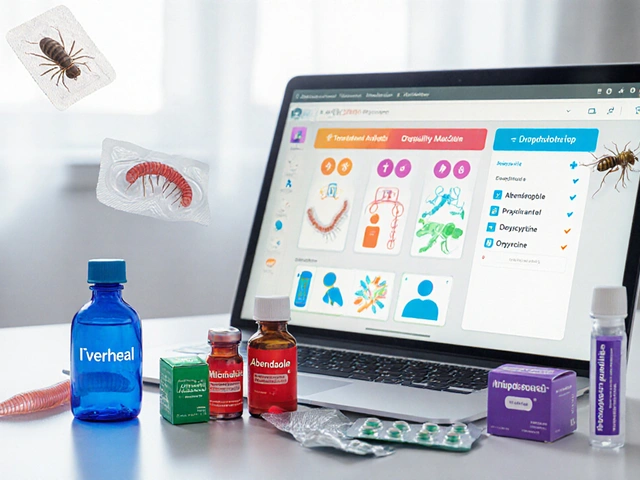Progesterone Option Selector
Find Your Best Progesterone Option
Answer these questions to find which progesterone option best matches your priorities. Based on the article comparison, we'll recommend the most suitable choice for your situation.
What matters most to you?
Do you need to avoid any side effects?
What's your preferred delivery method?
Why a Comparison Matters
When doctors prescribe Prometrium - a synthetic oral micronized progesterone, they expect a reliable source of Progesterone that mimics the body’s own hormone. But the market offers a mix of pills, gels, inserts, and compounded creams, each with its own pros and cons. If you’re juggling menopause symptoms, infertility treatment, or a hormone‑replacement plan, knowing how Prometrium stacks up against its alternatives can save you money, reduce side‑effects, and improve outcomes.
What Is Prometrium?
Prometrium is an FDA‑approved, oral micronized progesterone tablet. It contains 100 mg of progesterone per pill, derived from a plant source and processed to match the chemical structure of endogenous progesterone. Because it’s taken by mouth, it fits easily into a daily routine and is covered by most insurance plans for approved indications such as luteal‑phase support in IVF, prevention of endometrial hyperplasia, and hormone‑replacement therapy (HRT) for menopausal women.
How Oral Micronized Progesterone Works
Micronization creates tiny particles that dissolve quickly in the gastrointestinal tract, allowing the hormone to be absorbed into the bloodstream and travel to target tissues like the uterus, breast, and brain. Once inside cells, progesterone binds to progesterone receptors, triggering a cascade that prepares the uterine lining for implantation, stabilises mood, and reduces the risk of endometrial overgrowth.
Key Attributes to Compare
- Delivery method: oral tablet vs. vaginal gel, insert, cream, or injectable.
- Bioidentical status: true bioidentical (identical to human progesterone) or synthetic progestin.
- Dosage flexibility: fixed dose vs. titratable.
- Side‑effect profile: sedation, breast tenderness, gastrointestinal upset, mood changes.
- Cost & insurance coverage: out‑of‑pocket price, Medicare/PHI acceptance.
- Regulatory status: FDA‑approved product vs. compounded pharmacy preparation.

Popular Alternatives
Below are the most commonly prescribed or compounded progesterone options that patients compare with Prometrium.
Crinone (Vaginal Gel)
Crinone is a 90 mg progesterone gel applied once daily directly into the vagina. Because it bypasses the liver, blood levels rise more steadily, often resulting in fewer systemic side‑effects like drowsiness. It’s FDA‑approved for luteal‑phase support in assisted reproductive technology.
Endometrin (Vaginal Insert)
Endometrin delivers 100 mg of progesterone via a small, dissolvable insert placed in the vagina. The gel‑like consistency offers a controlled release over 8-12 hours, making it convenient for night‑time dosing.
Utrogestan (Capsule)
Utrogestan, popular in Europe and Canada, provides 200 mg of micronized progesterone per capsule. It’s taken orally like Prometrium but at a higher dose, which can be split for fine‑tuned therapy.
Compounded Bioidentical Progesterone Cream
Many compounding pharmacies create custom creams (usually 10-20 mg/g) that patients apply to the skin twice daily. Because absorption varies with skin type and application site, blood levels can be inconsistent, but the topical route avoids first‑pass metabolism altogether.
Medroxyprogesterone Acetate (MPA)
MPA is a synthetic progestin found in products like Depo‑Provera and Prempro. It’s not bioidentical; its molecular structure is different, leading to a distinct side‑effect profile that includes weight gain and potential lipid changes.
Norethindrone
Norethindrone is another synthetic progestin often used in combined oral contraceptives. While it provides reliable cycle control, it does not offer the same endometrial protective effects as true progesterone.
Side‑Effect Snapshot
Side‑effects differ mainly by delivery route and whether the product is bioidentical.
- Oral micronized progesterone (Prometrium, Utrogestan): mild sedation, bloating, breast tenderness.
- Vaginal gel/insert (Crinone, Endometrin): local irritation, discharge, rare systemic drowsiness.
- Topical cream: skin irritation, variable hormone levels.
- Synthetic progestins (MPA, norethindrone): weight gain, mood swings, altered lipid profile.
Cost Comparison (2025 US Prices)
| Product | Form | Bioidentical? | Typical Dose | Cost per Month (USD) | Common Side‑effects |
|---|---|---|---|---|---|
| Prometrium | Oral tablet | Yes | 100 mg daily | $45-$70 | Sleepiness, bloating |
| Crinone | Vaginal gel | Yes | 90 mg daily | $80-$120 | Local irritation, rare drowsiness |
| Endometrin | Vaginal insert | Yes | 100 mg nightly | $90-$130 | Discharge, discomfort |
| Utrogestan | Oral capsule | Yes | 200 mg daily (or split) | $55-$85 | Sleepiness, nausea |
| Compounded Cream | Topical | Yes (varies) | 10-20 mg/g twice daily | $60-$100 (depending on pharmacy) | Skin irritation, variable levels |
| Medroxyprogesterone Acetate | Oral/Injectable | No | 5-10 mg daily (oral) or 150 mg IM q3mo | $30-$50 | Weight gain, lipid changes |
| Norethindrone | Oral | No | 0.5-5 mg daily | $15-$35 | Mood swings, breakthrough bleeding |
Choosing the Right Option - A Quick Checklist
- Do you need oral convenience? If yes, Prometrium or Utrogestan are top picks.
- Are you sensitive to systemic drowsiness? Vaginal routes (Crinone, Endometrin) may reduce that risk.
- Is insurance coverage a priority? FDA‑approved oral tablets often have better reimbursement than compounded creams.
- Do you prefer a bioidentical hormone? Stick with true progesterone products; avoid synthetic progestins unless specifically indicated.
- Is cost the main driver? Synthetic progestins like MPA are cheapest, but weigh the trade‑off in side‑effects.

Real‑World Scenarios
Scenario 1 - IVF luteal support: A 34‑year‑old undergoing embryo transfer wants the most reliable blood levels. Many clinics start with Crinone because vaginal delivery avoids first‑pass metabolism, but if the patient has vaginal irritation, switching to oral Prometrium at 100 mg twice daily is an evidence‑backed alternative.
Scenario 2 - Menopause symptom relief: A 57‑year‑old prefers a simple nightly pill and wants insurance coverage. Prometrium at 100 mg nightly provides mood stability and protects the uterus, while avoiding the higher out‑of‑pocket cost of vaginal inserts.
Scenario 3 - Compounded cream user: A 42‑year‑old uses a 20 mg/g cream for perimenopause but reports erratic mood swings. Switching to a FDA‑approved oral tablet gives predictable serum progesterone and eliminates the guesswork of skin absorption.
Potential Pitfalls and How to Avoid Them
- Incorrect dosing: Some patients split a 200 mg tablet to mimic a 100 mg dose, which can lead to uneven absorption. Use the dosage form that matches the prescribed strength.
- Drug interactions: Oral progesterone can increase the effect of CNS depressants (e.g., benzodiazepines). Review all meds with your provider.
- Insurance denials: If a claim for Prometrium is denied, ask the pharmacy for a prior‑authorization code or consider an FDA‑approved generic equivalent where available.
- Compliance issues: Vaginal gels must be stored at room temperature; exposure to heat reduces potency. Keep them in a cool, dry place.
Bottom Line - Which One Wins?
There’s no one‑size‑fits‑all answer. If you value oral simplicity, solid insurance coverage, and proven bioidentical chemistry, Prometrium often edges out the others. For patients who experience pronounced sedation or have gastrointestinal sensitivity, a vaginal gel or insert like Crinone or Endometrin can deliver steadier hormone levels with fewer systemic effects. Synthetic progestins remain low‑cost options but sacrifice the natural hormone match and may carry different metabolic risks.
Ask your healthcare provider to weigh your medical history, cost considerations, and personal preferences against the comparison points above. The right choice is the one that aligns with your health goals while keeping side‑effects manageable.
Next Steps
- Schedule a follow‑up with your prescriber to discuss which formulation fits your lifestyle.
- Check your insurance formulary for coverage details on Prometrium versus alternatives.
- Track any side‑effects using a simple diary for at least two weeks after starting a new product.
- If you switch formulations, allow a 5‑7 day washout period to avoid overlapping hormone peaks.
- Consider a serum progesterone test after 2 weeks to confirm you’re hitting the therapeutic range.
Can I take Prometrium and a synthetic progestin at the same time?
Usually not. Combining a bioidentical progesterone with a synthetic progestin can lead to excess hormone levels and increase side‑effects like mood swings or weight gain. Always discuss combination therapy with your doctor.
Is Prometrium safe during pregnancy?
Prometrium is often prescribed for luteal‑phase support in IVF, which involves early pregnancy. Outside of assisted reproduction, routine use in a confirmed pregnancy isn’t recommended without specialist guidance.
Do I need a prescription for compounded progesterone cream?
Yes. Compounded creams require a physician’s prescription because the formulation, concentration, and dosage must be tailored to your individual needs.
How long does it take for oral progesterone to work?
Peak serum levels appear 2-4 hours after taking a tablet. Clinical effects, like endometrial protection, usually require a few days of consistent dosing.
Can I switch from Crinone to Prometrium without a washout period?
Because both deliver progesterone, a short overlap isn’t harmful, but it may raise hormone levels temporarily. Most clinicians advise a 24‑hour gap to avoid excess sedation.






Latasha Becker
October 18, 2025 AT 22:40While the article extols Prometrium’s pharmacokinetic profile, it neglects to acknowledge the first‑pass hepatic metabolism that attenuates bioavailability relative to vaginal formulations. The micellar dispersion of micronized particles indeed expedites dissolution, yet the resultant plasma concentration curve exhibits a pronounced Cmax trough that can precipitate sub‑therapeutic luteal support. Moreover, the asserted cost‑effectiveness fails to incorporate the cumulative out‑of‑pocket expenditure incurred by insurance copays and pharmacy tiering. In contrast, Crinone’s intravaginal delivery circumvents hepatic clearance, thereby preserving the native progesterone AUC. Consequently, clinicians ought to calibrate therapeutic regimens on a per‑patient pharmacodynamic substrate rather than relying on a monolithic cost metric.
parth gajjar
October 21, 2025 AT 22:53It’s heartbreaking how the market‑driven hype blinds us to the subtle hormonal choreography that truly matters; we are left to swallow glossy brochures while our endocrine rhythms scream for balance.
One cannot help but feel the tragedy of a woman’s night ruined by a tablet that drifts into oblivion before dawn.
Maridel Frey
October 24, 2025 AT 23:06When evaluating progesterone options, it is prudent to first delineate the therapeutic objective-whether luteal phase support, menopausal symptom mitigation, or endometrial protection. Oral micronized progesterone, such as Prometrium, offers the convenience of daily ingestion and broad insurance acceptance, but clinicians should monitor for drowsiness and gastrointestinal discomfort. Vaginal preparations like Crinone or Endometrin provide steadier serum levels by bypassing hepatic first‑pass metabolism, which may be advantageous for patients with sensitivity to systemic side‑effects. Compounded creams, while customizable, often exhibit variable absorption and should be considered only when standard formulations are contraindicated. Ultimately, shared decision‑making that incorporates patient lifestyle, comorbidities, and cost considerations will yield the most satisfactory outcome.
Madhav Dasari
October 27, 2025 AT 22:20Wow, you nailed it! 🎉 If you’re juggling a hectic schedule, the simplicity of popping a pill at night can feel like a lifesaver, but don’t underestimate the power of a well‑placed vaginal gel to keep hormone swings at bay. I’ve seen friends swap from creams to an oral tablet and watch their mood swing chart flatten like never before. Keep the conversation going-your body knows best, and a little trial‑and‑error can uncover the sweet spot that keeps you feeling balanced and energetic.
Jay Kay
October 30, 2025 AT 22:33Prometrium’s price tag simply can’t compete with the cheap, albeit less natural, synthetic progestins.
Jameson The Owl
November 2, 2025 AT 22:46It is evident that the pharmaceutical conglomerates orchestrate the narrative surrounding oral micronized progesterone to steer physicians toward brand‑name products while systematically downplaying the efficacy and safety of cheaper alternatives such as compounded creams or generic oral capsules because the profit margins on patented oral tablets like Prometrium are astronomical and the regulatory agencies, beholden to industry lobbying, deliberately obfuscate comparative data, thereby ensuring that patients remain dependent on a market that values corporate gain over transparent, evidence‑based care, a reality that should alarm anyone who believes in a truly free medical marketplace.
Rakhi Kasana
November 5, 2025 AT 23:00While the oral route undeniably offers convenience, one must also weigh the intermittent sedation that some patients report, especially during the first weeks of therapy; the vaginal gels, albeit slightly more cumbersome to administer, tend to produce a steadier hormonal milieu with fewer systemic complaints, making them a compelling alternative for individuals with sensitive gastrointestinal tracts.
Sarah Unrath
November 8, 2025 AT 23:13i think the table on cost could use a note that insurance varies a lot its not the same for everyone
James Dean
November 11, 2025 AT 23:26Considering the myriad progesterone delivery methods invites reflection on how modern medicine balances biochemical precision with lived experience, reminding us that pharmacology is as much an art of interpretation as it is a science of molecules.
Penny Reeves
November 14, 2025 AT 23:40From a pharmacodynamic perspective, the half‑life differentials between oral and vaginal formulations are not mere academic footnotes but critical determinants of endometrial receptivity; a 100 mg oral dose of Prometrium yields a peak plasma concentration within 2‑4 hours, whereas intravaginal gel maintains a plateau that more closely mimics the luteal phase’s natural progesterone curve. Consequently, clinicians who prioritize a seamless serum trajectory should contemplate adjunctive dosing schedules or alternative routes to mitigate the troughs inherent to oral administration. Nonetheless, cost constraints and patient adherence often dictate the final therapeutic choice, underscoring the perennial tension between ideal pharmacokinetics and pragmatic healthcare delivery.
Sunil Yathakula
November 17, 2025 AT 23:53Hey there, I totally get how confusing all these options can seem.
The first thing to remember is that your body is unique and will react differently to each formulation.
Oral tablets like Prometrium are great if you want a simple once‑daily routine.
Just make sure you take them with food to reduce any stomach upset.
Vaginal gels such as Crinone are super effective for steady hormone levels but you might need a little practice to get the applicator right.
If you find the gel messy, the inserts like Endometrin offer a tidy nighttime option.
Compounded creams can be tailored to a specific dosage, yet the absorption can vary based on where you apply them.
Many patients report skin irritation, so start with a small amount and monitor your skin.
Synthetic progestins are cheaper but they come with a different side‑effect profile that may include weight changes or mood swings.
It’s worth chatting with your prescriber about doing a serum progesterone test after a couple of weeks to see if you’re in the therapeutic range.
Keep a simple diary noting any drowsiness, bloating, or mood shifts; this data can guide dose adjustments.
If insurance refuses coverage for a preferred brand, ask for a prior‑authorization appeal; pharmacies are often willing to help.
Remember that switching between routes typically only needs a short 24‑hour gap to avoid overlapping peaks.
Most importantly, listen to how you feel day‑to‑day rather than relying solely on numbers.
You’ve got this, and with a bit of trial‑and‑error you’ll land on the regimen that keeps you balanced and thriving.